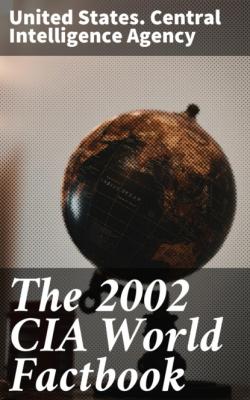ТОП просматриваемых книг сайта:
The 2002 CIA World Factbook. United States. Central Intelligence Agency
Читать онлайн.Название The 2002 CIA World Factbook
Год выпуска 0
isbn 4064066092382
Автор произведения United States. Central Intelligence Agency
Жанр Социология
Издательство Bookwire
Railways: total: 24.6 km broad gauge: 9.6 km 1.524-m gauge from
Gushgy (Turkmenistan) to Towraghondi; 15 km 1.524-m gauge from Termiz
(Uzbekistan) to Kheyrabad transshipment point on south bank of Amu Darya
(2001)
Highways: total: 21,000 km paved: 2,793 km unpaved: 18,207 km (1998 est.)
Waterways: 1,200 km note: chiefly Amu Darya, which handles vessels up to 500 DWT (2001)
Pipelines: natural gas 180 km note: product pipelines from Uzbekistan and Turkmenistan have been in disrepair and disuse for years (2002)
Ports and harbors: Kheyrabad, Shir Khan
Airports: 46 (2001)
Airports - with paved runways: total: 10 over 3,047 m: 3 2,438 to 3,047 m: 4 under 914 m: 1 (2001) 1,524 to 2,437 m: 2
Airports - with unpaved runways: 7 1,524 to 2,437 m: Heliports: 2 (2001)
Military Afghanistan
Military branches: NA; note - the December 2001 Bonn Agreement calls for all militia forces to come under Afghan Interim Authority (AIA) control, but formation of a national army is likely to be a gradual process; Afghanistan's forces continue to be factionalized largely along ethnic lines
Military manpower - military age: 22 years of age (2002 est.)
Military manpower - availability: males age 15-49: 6,896,623 (2002 est.)
Military manpower - fit for military service: males age 15-49: 3,696,379 (2002 est.)
Military manpower - reaching military age annually: males: 252,869 (2002 est.)
Military expenditures - dollar figure: $NA
Military expenditures - percent of GDP: NA%
Transnational Issues Afghanistan
Disputes - international: close ties with Pashtuns in Pakistan make long border difficult to control
Illicit drugs: poppy ban cut 2001 cultivation by 97% to 1,695 hectares, with potential production of 74 tons of opium; a major source of hashish; many heroin-processing laboratories throughout the country; major political factions in the country profit from the drug trade
This page was last updated on 1 January 2002
========================================================================
Algeria
Introduction
Algeria
Background: After a century of rule by France, Algeria became independent in 1962. The surprising first round success of the fundamentalist FIS (Islamic Salvation Front) party in the December 1991 balloting caused the army to intervene, crack down on the FIS, and postpone the subsequent elections. The FIS response has resulted in a continuous low-grade civil conflict with the secular state apparatus, which nonetheless has allowed elections featuring pro-government and moderate religious-based parties. FIS's armed wing, the Islamic Salvation Army, disbanded itself in January 2000 and many armed militants surrendered under an amnesty program designed to promote national reconciliation. Nevertheless, residual fighting continues. Other concerns include Berber unrest, large-scale unemployment, a shortage of housing, and the need to diversify the petroleum-based economy.
Geography Algeria
Location: Northern Africa, bordering the Mediterranean Sea, between
Morocco and Tunisia
Geographic coordinates: 28 00 N, 3 00 E
Map references: Africa
Area: total: 2,381,740 sq km water: 0 sq km land: 2,381,740 sq km
Area - comparative: slightly less than 3.5 times the size of Texas
Land boundaries: total: 6,343 km border countries: Libya 982 km, Mali 1,376 km, Mauritania 463 km, Morocco 1,559 km, Niger 956 km, Tunisia 965 km, Western Sahara 42 km
Coastline: 998 km
Maritime claims: exclusive fishing zone: 32-52 NM territorial sea: 12 NM
Climate: arid to semiarid; mild, wet winters with hot, dry summers along coast; drier with cold winters and hot summers on high plateau; sirocco is a hot, dust/sand-laden wind especially common in summer
Terrain: mostly high plateau and desert; some mountains; narrow, discontinuous coastal plain
Elevation extremes: lowest point: Chott Melrhir -40 m highest point:
Tahat 3,003 m
Natural resources: petroleum, natural gas, iron ore, phosphates, uranium, lead, zinc
Land use: arable land: 3% permanent crops: 0% other: 97% (1998 est.)
Irrigated land: 5,600 sq km (1998 est.)
Natural hazards: mountainous areas subject to severe earthquakes; mudslides and floods in rainy season
Environment - current issues: soil erosion from overgrazing and other poor farming practices; desertification; dumping of raw sewage, petroleum refining wastes, and other industrial effluents is leading to the pollution of rivers and coastal waters; Mediterranean Sea, in particular, becoming polluted from oil wastes, soil erosion, and fertilizer runoff; inadequate supplies of potable water
Environment - international agreements: party to: Biodiversity, Climate
Change, Desertification, Endangered Species, Environmental Modification,
Hazardous Wastes, Law of the Sea, Ozone Layer Protection, Ship Pollution,
Wetlands signed, but not ratified: Geography - note: second-largest
country in Africa (after Sudan)
People Algeria
Population: 32,277,942 (July 2002 est.)
Age structure: 0-14 years: 33.5% (male 5,512,369; female 5,311,914) 15-64 years: 62.4% (male 10,175,135; female 9,950,315) 65 years and over: 4.1% (male 610,643; female 717,566) (2002 est.)
Population growth rate: 1.68% (2002 est.)
Birth rate: 22.34 births/1,000 population (2002 est.)
Death rate: 5.15 deaths/1,000 population (2002 est.)
Net migration rate: -0.42 migrant(s)/1,000 population (2002 est.)
Sex ratio: at birth: 1.04 male(s)/female under 15 years: 1.04 male(s)/female 15-64 years: 1.02 male(s)/female 65 years and over: 0.85 male(s)/female total population: 1.02 male(s)/female (2002 est.)
Infant mortality rate: 39.15 deaths/1,000 live births (2002 est.)
Life expectancy at birth: 71.67 years (2002 est.) male: Total fertility rate: 2.63 children born/woman (2002 est.)
HIV/AIDS - adult prevalence rate: 0.07% (1999 est.)
HIV/AIDS - people living with HIV/AIDS: NA
HIV/AIDS - deaths: NA
Nationality: noun: Algerian(s) adjective: Algerian
Ethnic groups: Arab-Berber 99%, European less than 1%
Religions: Sunni Muslim (state religion) 99%, Christian and Jewish 1%
Languages: Arabic (official), French, Berber dialects
Literacy: definition: age 15 and over can read and write total population: 61.6% male: 73.9% female: 49% (1995 est.)
Government Algeria
Country name: conventional long form: People's Democratic Republic of
Algeria conventional short form: Algeria local short form: Al Jaza'ir
local long form: Al Jumhuriyah al Jaza'iriyah ad Dimuqratiyah ash
Sha'biyah
Government type: republic
Capital:

